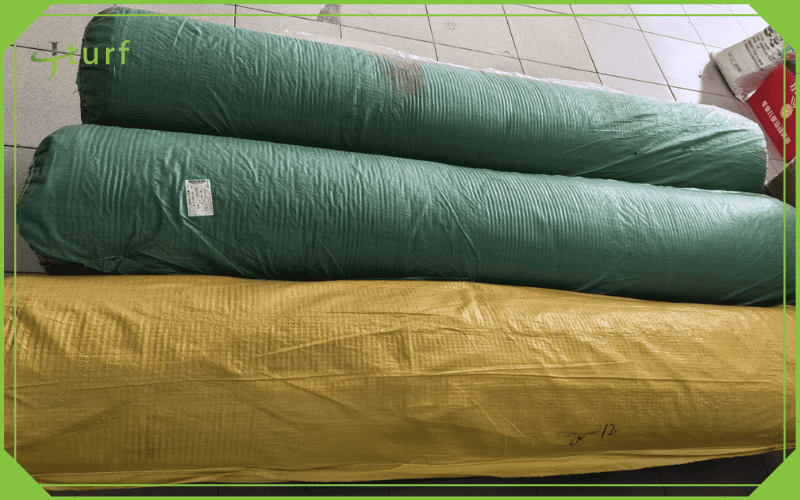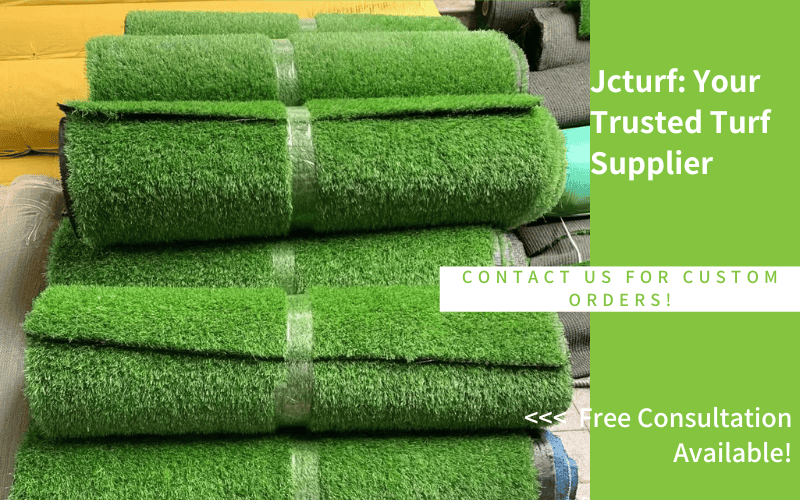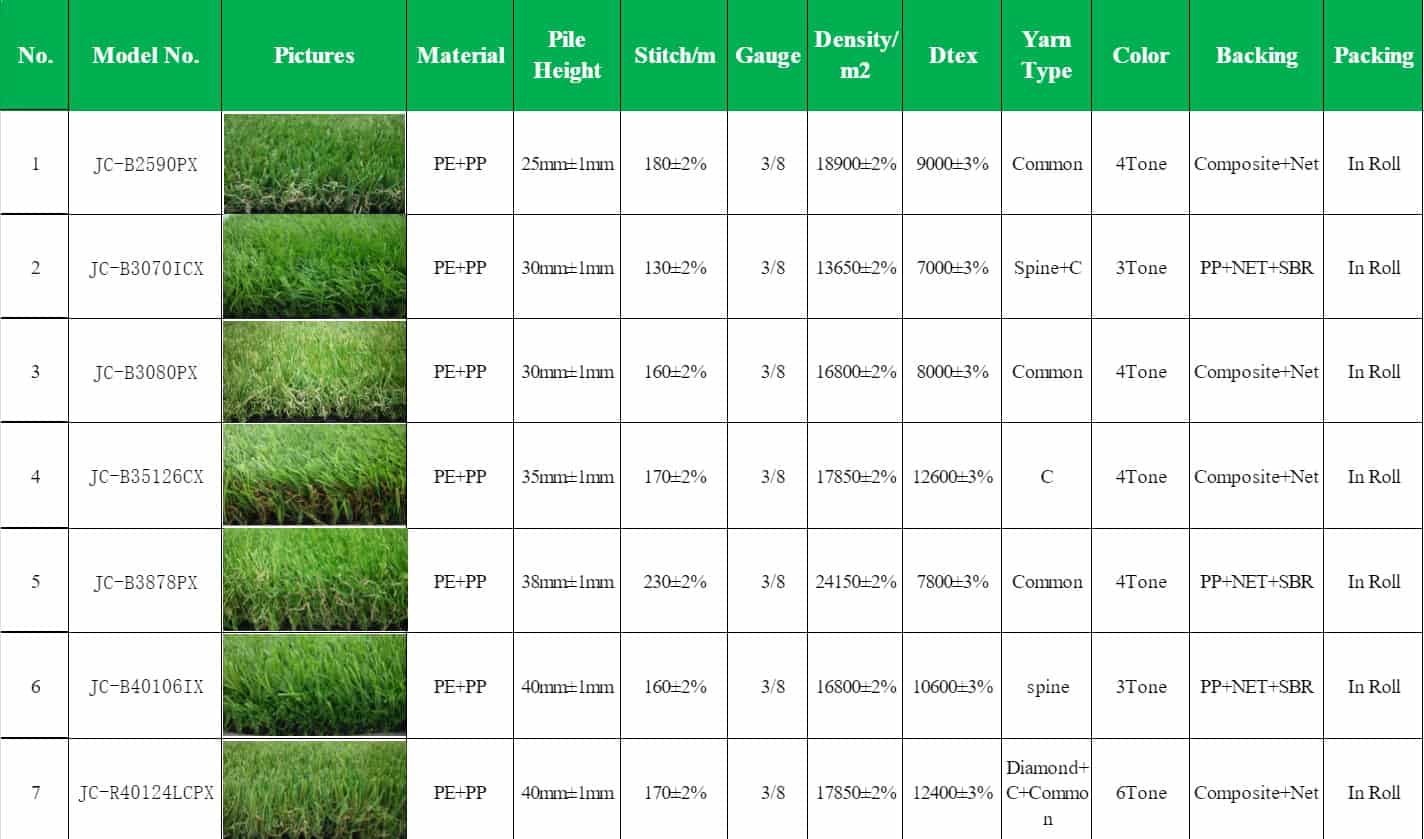A roll of artificial turf typically weighs between 750 and 1,000 pounds. The exact weight depends on the roll’s size, backing, pile height, and whether infill is included. On average, turf weighs about 0.5 to 1 pound per square foot.
In this guide, you’ll find a quick overview of standard roll weights, a breakdown of what makes some rolls heavier than others, and a full chart of common turf sizes with estimated weights. We’ll also explain how turf weight affects delivery, installation, and storage—plus show you how to estimate weight on your own. Finally, we’ll clarify whether heavier turf actually means better quality (spoiler: not always).
Average Weight of a Turf Roll
The average weight of a turf roll depends on its size and material, but for most standard options, you’re looking at 0.5 to 1 pound per square foot. That means a full-size roll—typically 15 feet wide and 100 feet long—can weigh between 750 and 1,000 pounds.
For smaller projects, rolls are often cut to more manageable sizes. Here’s a quick reference:
- 7.5 ft x 25 ft → around 100–130 lbs
- 15 ft x 25 ft → around 250–300 lbs
- 15 ft x 50 ft → around 500–600 lbs
These figures can vary slightly depending on the turf’s pile height, density, and whether the roll includes infill or heavy-duty backing.
If you’re ordering turf, always ask for the product specs. It’ll help you plan for delivery, storage, and installation. Heavy rolls may require two people—or even machinery—to move safely.
What Affects the Weight of Artificial Turf Rolls
Not all turf rolls weigh the same. Several key factors affect how heavy a roll of artificial grass can be—including the height of the blades, how densely it’s stitched, the type of backing, and whether infill is included. Let’s break these down one by one.
Pile Height
Taller blades mean more material—and more weight. A turf with a 40mm pile height is significantly heavier than one with 20mm, even if the size is the same.
Density and Stitch Rate
The closer the fibers are packed, the denser and heavier the turf. Higher stitch rates usually mean better durability, but also more weight per square foot.
Backing Material
Heavy-duty backings like polyurethane or latex add to the total weight. Some lighter turfs use single-layer or non-backed materials to reduce load.
Infill (if Pre-Added)
Some turf rolls come pre-filled with sand or rubber infill. This can greatly increase the weight—sometimes doubling it—so always check if infill is included.
Common Sizes and Their Corresponding Weights
Artificial turf is sold in many different roll sizes, each with a different weight depending on the area and material. Below is a quick-reference chart showing typical dimensions and their estimated dry weights, based on standard 40mm pile height and typical backing.
| Size (ft) | Area (sq ft) | Approx. Weight (lbs) | Common Use |
| 5 × 10 | 50 | 25–35 | Balcony, pet zone, sample areas |
| 7.5 × 25 | 187.5 | 100–130 | Narrow strips, side yard |
| 12 × 30 | 360 | 200–250 | Front yards, flexible installs |
| 15 × 25 | 375 | 250–300 | Standard residential lawn |
| 15 × 50 | 750 | 500–600 | Mid-size home lawn |
| 15 × 60 | 900 | 600–700 | Larger residential spaces |
| 15 × 75 | 1,125 | 750–850 | Light commercial or multi-zone |
| 15 × 100 | 1,500 | 900–1,000 | Full commercial roll |
Keep in mind: added infill or heavier backing will increase the total weight. For custom sizes or unusual specs, always ask your turf supplier for detailed product sheets.
Why Turf Roll Weight Matters
Turf weight isn’t just a technical detail—it impacts how your whole project runs. It affects how the rolls are delivered, how easy they are to install, where and how you store them, and how stable they feel after installation. Knowing the weight of your artificial grass roll helps you choose the right size, arrange the proper tools or manpower, and avoid last-minute surprises. Here’s how turf weight plays a role at each step.

Delivery and Transport
Heavy turf rolls can’t always be handled manually. A full roll may require a dolly, forklift, or multiple people to unload—especially if the delivery is curbside only. Planning for this ahead of time helps you avoid delays and damaged goods.
Installation Planning
Lighter rolls are easier to lift, lay down, and reposition. If you’re working alone or with a small crew, knowing the roll’s weight helps you match the roll size to your physical capacity and prep the right tools.
Storage and Access
Rolls should be stored flat and kept dry. Heavier rolls can be harder to move through gates, doorways, or narrow walkways. These areas are often overlooked during planning, but they can make or break your delivery day.
Surface Performance and Stability
Heavier turf tends to sit more firmly on the ground. It’s less likely to shift, wrinkle, or curl at the edges—especially in windy conditions or on sloped surfaces. That said, the ideal weight depends on your site layout and how much handling help you have.
How to Measure or Estimate Turf Roll Weight
If your turf roll doesn’t come with a listed weight, you can still get a solid estimate. There are three practical ways to do it: calculating it manually, using an online calculator, or requesting product specs from your supplier. Each method works best in different situations:
Manual Calculation
Most artificial turf weighs between 0.5 and 1 lb per square foot. Multiply the roll’s area (length × width) by the estimated weight per square foot.
Tip: If the turf has a higher pile (like 40mm or more), use the upper range (0.9–1 lb). Lower-pile or lightweight turf may fall closer to 0.5 lb/sq ft.
Online Estimation Tools
Some brands and turf suppliers offer turf weight calculators on their websites. Just enter the roll’s dimensions and pile height for an instant estimate. Try using phrases like “turf weight calculator” along with the brand name.
Requesting Product Specs
The most accurate way is to ask your supplier for the technical datasheet (also called a spec sheet). It usually includes the exact weight per square foot, backing material, and whether infill is included. These are often downloadable from brand websites or available through distributors.
Does Turf Weight Indicate Quality?
Not necessarily. While heavier turf may feel more substantial, weight alone isn’t a true measure of quality. A roll can be heavy due to thick backing or dense fiber—but that doesn’t always mean better durability or comfort.
In fact, lighter turfs can perform better in some settings, like rooftop installations or temporary event flooring. What really defines quality is UV resistance, fiber recovery, drainage, and how well the turf fits your intended use.
Always read the spec sheet—don’t judge turf by weight alone.


